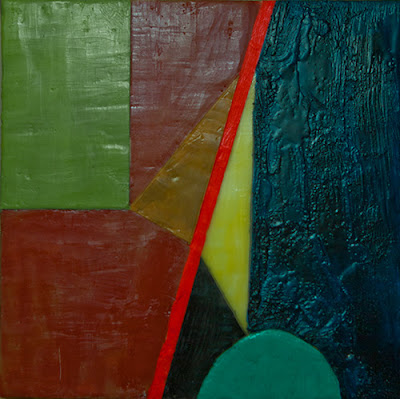A week or so ago I watched a short video by
Paula Roland and decided I wanted to investigate creating encaustic monotypes. Not being able to afford a hotbox, nor an anodized aluminum plate, I thought--well, that's out. Until this morning.
In spending my Christmas money for things encaustic, I of course bought a pancake griddle. Non-cook that I am, I assumed they only varied in size. Not so. My lovely new palette had a surface criss-crossed with a recessed diamond pattern. Worked fine, except when I came to clean it. After a few weeks and rolls of paper towels, I decided I would put a piece of glass on it. And, that did it. Nice smooth, cleanable palette.
This morning I woke up realizing I had a hot box. I did a bit more reading and discovered a wonderful Montreal artist, Alexandre Masimo who very kindly wrote
a most helpful post about encaustic monotyping. That post and his work set me to work immediately.
I drew two rectangles (B in the image above) on a piece of ordinary printer paper. The outer one for the size of the torn paper I would use. The inner one (in red), the size the composed image would be. I slipped this under the glass (A is pointing to the glass which is invisible in this image.). You want that outer rectangle matched to the overall size of your paper so that when you want to layer pulls, you can place your paper in the same place each time in relation to the print area. (Before I started anything I checked to make sure the griddle was level--this is important as your pools of wax on the palette will run if the surface is not level.)
What you see on the griddle-glass hotbox is the remnant of wax after the print on the right was pulled. This one was done on a scrap of paper left over from my intaglio days. Those were so long ago I no longer remember the name of the paper, but is it some form of mulberry or rice paper, though not terribly thin. I used a hard acrylic roller with a sheet of freezer paper (shiny side down) between my print paper and the roller to keep the wax from bleeding through onto the roller.
On the right is the very first print I pulled just to see if all this would work. I had no blue wax sticks so into a bit of melted beeswax on the palette, I added some phthalo blue and titanium white pigment. Not fussy at this point as this is a test.
Alexandre taught me that because "normal" encaustic work occurs on a firm surface, damar resin is added to the beeswax to make the wax stiffer, but any stiffness is not good on flexible paper. All commercially produced encaustic colors are prepared with some amount of damar resin. I'm fine with that because I make my own medium and colors anyway. I have a few Enkaustikos sticks just to play with, but far more jars of pigment powders.
On the left is the second test print I did. I will be exploring ways to mix control with serendipity in this process. And, of course, exploring the latitude that multiple pulls will afford. It will also be interesting to see if I can make a straight edge with this process.
Even though I am deeply immersed in
regular encaustic work right now, I wanted to give folks who want to experiment with encuastic monotypes a way to do that without selling your firstborn. Obviously with this setup your work is constrained by the griddle size. Especially if you only have one griddle. Ideally two griddles would solve that problem--one for the "poor-man's hot box" and one for a palette. You could easily get a 9" x 12" print then. But, everything you can do with a hot box, you can do with this setup.







